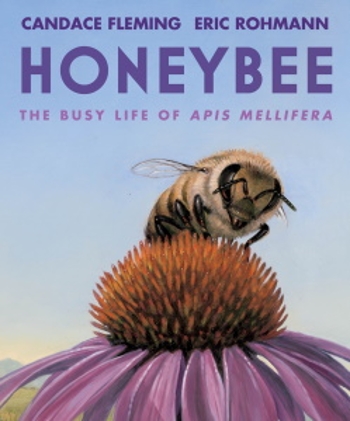Humans depend on honeybee pollination for many of the foods we eat. This resourceful and hard-working insect deserves an epic picture book salute, and Honeybee: The Busy Life of Apis Mellifera more than delivers. This wildly informative tribute chronicles the brief yet eventful life of one dedicated worker bee named Apis. Thanks to the highly detailed and realistic oil paintings created by previous Caldecott winner Eric Rohmann, Honeybee offers an up-close and personal look at the glory that is Apis.
 According to National Geographic, the average size of a worker honeybee is between 0.4 to 0.6 inches. And yet this little critter serves a mighty role in the food chain. Some humans may view bees as a pest, but we depend on honeybee pollination for many of the foods we eat. This resourceful and hard-working insect deserves an epic picture book salute, and Honeybee: The Busy Life of Apis Mellifera more than delivers. This remarkably informative tribute chronicles the brief yet eventful life of one dedicated worker bee named Apis. Thanks to the highly detailed and realistic oil paintings created by Eric Rohmann, 1995 Caldecott Honor winner for Time Flies and 2003 Caldecott winner for My Friend Rabbit, Honeybee offers an up-close-and-personal look at the glory that is Apis.
According to National Geographic, the average size of a worker honeybee is between 0.4 to 0.6 inches. And yet this little critter serves a mighty role in the food chain. Some humans may view bees as a pest, but we depend on honeybee pollination for many of the foods we eat. This resourceful and hard-working insect deserves an epic picture book salute, and Honeybee: The Busy Life of Apis Mellifera more than delivers. This remarkably informative tribute chronicles the brief yet eventful life of one dedicated worker bee named Apis. Thanks to the highly detailed and realistic oil paintings created by Eric Rohmann, 1995 Caldecott Honor winner for Time Flies and 2003 Caldecott winner for My Friend Rabbit, Honeybee offers an up-close-and-personal look at the glory that is Apis.
Following the format of Rohmann's Sibert Honor-winning collaboration with Candace Fleming, Giant Squid, the action in Honeybee starts before the title page. In many of his books, Rohmann likes to visually introduce his subjects gradually, and this technique works well here. He takes readers inside a nest where Apis "squirms, pushes, chews" her way out of a waxy solitary cell, with only part of her face visible on one page and then half her body appearing on the next. Apis seems to make eye contact with the reader, but Rohmann avoids cutesy anthropomorphism. In the book's first gasp-inducing moment, Rohmann pulls back to reveal that several bees actually surround Apis on a double-page spread that serves as the book's title page. This image is so vivid, readers can practically hear the buzzing.
The next several pages show Apis working hard in the nest. Rohmann's attention to detail impresses. He puts care into capturing every minute detail of the honeybee's body. These are not stylized or cartoony drawings, but hyper-realistic depictions of Apis's anatomy. Those shiny eyes, intricate wings, and flicking tongues are realistically rendered. The bee's fuzziness is especially compelling. Imagine the time Rohmann must have spent painting each individual strand of hair. The book's large dimensions (9.78 x 0.39 x 11.84 inches) serve Rohmann's work beautifully. Many of the double-page spreads have a cinematic, wide-screen feel, as Apis eats sticky pollen, nurses grublike larvae of various sizes, tends to the queen, and labors at comb-building. The color palette gravitates toward orange, golden yellow, black, and brown, deftly conveying the nest's darkness without losing visual clarity. One striking spread places the reader eye-to-eye, mandible-to-mandible, antennae-to-antennae with Apis as she cleans the hive's nursery. Bee-averse folks might recoil, but this is undeniably fascinating imagery.
Honeybee builds to a big moment—when Apis finally takes flight. In an effective touch, author Fleming keeps asking whether the bee is ready to fly. This narrative hook keeps the pages turning. Fleming's brilliant, informative, poetic text deserves special attention. Her words have a drive, a surprising emotional immediacy. After such a dramatic build-up, the scene where Apis starts flying needs to excel on a visual level. Rohmann delivers. Apis starts getting closer and closer to the outside world. She bumps furry heads with a forager bee, dusted with pollen and "smelling of sunshine and fresh air." Look at those specks of pollen dust on her fur. Her next, more brutal job consists of guarding the nest's entrance and wrestling with an intrusive robber bee, threatening her home. Finally, she can now soar. Rohmann shows her from behind at the nest's entrance, ready to leap into the air with others watching. Does she seem nervous while facing the inviting blue sky and green leaves?
And now there is the biggest gasp-inducing moment in the book. As Apis finally flies, the book's pages fold out for a thrilling panoramic view of a field lit up by the morning sun. Light blues, greens, and purples warm the pages. This showstopping spread works as a striking visual contrast to the dark world of the nest. For one amazing moment, she flies solo. The next spread shows other bees surrounding Apis, as they search for water, propolis, pollen, and nectar. Rohmann provides an excellent overhead view of Apis landing on a purple coneflower, seeking the nectar inside. She then heads back to the hive, where she does a wagging dance to tell the other bees, who are gathered around to watch and learn, where they can find this delicious nectar.
[Read the Horn Book Magazine review of Honeybee here]
One of the surprising things about Honeybee is the book's emotional punch. Apis may have an eventful and busy life, but she does not live a very long time. The final three spreads are incredibly moving. One shows Apis toward the end of her life, around 35 days old, in mid-air near a yellow flower. She has accomplished a lot in her short life, and "her work is done." Rohmann positions her head so she is looking at the reader, as if saying goodbye. The scene does not feel cloying or overly sentimental, but rather one that celebrates the connection between Apis and the reader. On the next page, Apis dies, and by surrounding her with comforting, round green leaves and clovers as she passes away, Rohmann gives her a warm, dignified send-off. A flip of the page takes the reader back to the book's beginning, with a brand-new honeybee emerging from the wax cap of her solitary cell. The cycle of life continues.
Thanks to the perfect combination of Candace Fleming's dynamic text and Eric Rohmann's dramatic paintings, Honeybee is, quite simply, an unforgettable picture book experience. Throw in a striking anatomical drawing of a honeybee in the back matter, and readers fly away with a new understanding of this remarkable creature that we all need for our survival.
Honeybee soars.

ALREADY A SUBSCRIBER? LOG IN
We are currently offering this content for free. Sign up now to activate your personal profile, where you can save articles for future viewing.








Add Comment :-
Comment Policy:
Comment should not be empty !!!
Sam Juliano
"Those shiny eyes, intricate wings, and flicking tongues are realistically rendered. The bee's fuzziness is especially compelling. Imagine the time Rohmann must have spent painting each individual strand of hair." Brian, you are at your descriptive best here in this trenchant and passionate examination of another huge personal favorite from this dream team collaboration. When you speak about short life spans and the wrenching emotions visiting the readers, I also think of this past year's Oscar winning documentary "My Octopus Teacher," which bears some thematic kinship to HONEYBEE. Your discussion of the illustrator's command of detail too is extraordinary.Posted : Sep 18, 2021 02:05
Allison Grover Khoury
allisongroverkhoury@gmail.com Thanks for this excellent review. I am a huge fan of Eric Rohmann and I LOVED Giant Squid, as did my students. He really knows how to maximize a double-page spread and sneak in a bonus fold-out pages view that really does make the reader gasp! I look forward to seeing this book in person.Posted : Oct 12, 2020 01:14